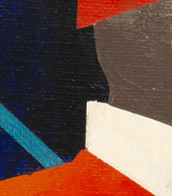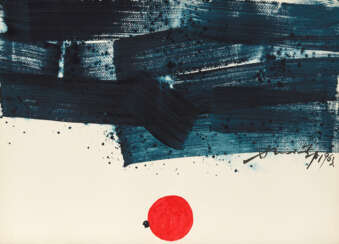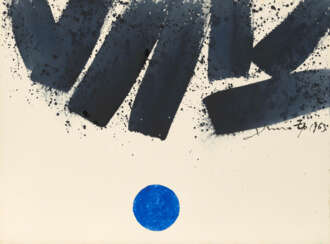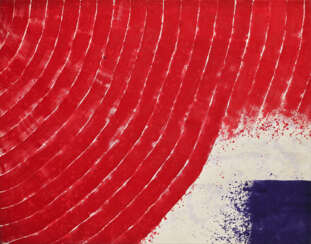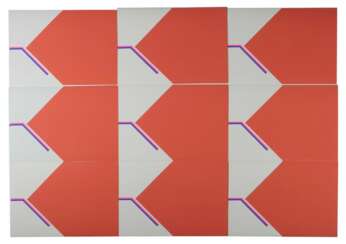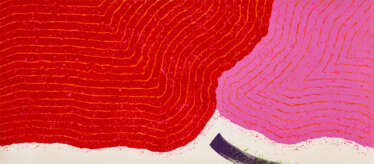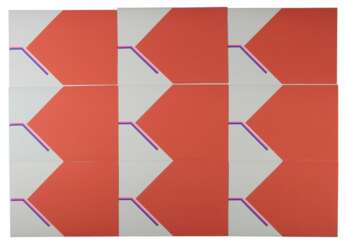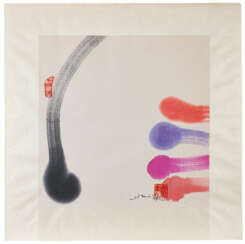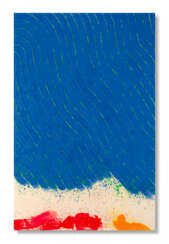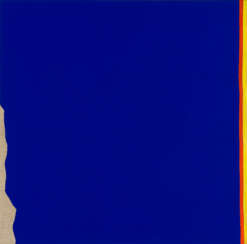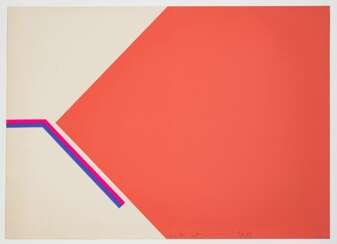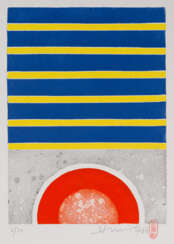hsiao chin (1935 - 2023)

Hsiao Chin is a Chinese modernist painter who has worked in Europe.
Born into an intellectual family in Shanghai, Hsiao moved to Taiwan in 1949 and was educated in the art department of the Taipei Teachers' Training School in Taiwan Province of Taipei (now National Taipei Teachers' University). In 1955, he and seven other artists founded the Ton Fan Art Group, the first postwar contemporary art group in Taiwan that attempted to break free from realism and sought a modern expression of Eastern spirituality.
As an innovative artist and co-founder of significant modernist movements in Taiwan and Europe, Hsiao's work explored Asian philosophy while embracing forms of Western postwar avant-garde practices.
In the mid-1950s, Hsiao settled in Milan, where he lived for half a century. In 1961, along with Italian painter Antonio Calderara and Japanese sculptor Adzuma Kenjiro in Milan, he co-founded the Punto movement, which brought together numerous Eastern and Western abstractionist artists. Xiao Qin's work has been exhibited around the world, including New York's MoMA and Metropolitan Museum of Art, the National Art Museum of China, the Museum of Contemporary Art in Barcelona, and the National Taiwan Museum of Art.
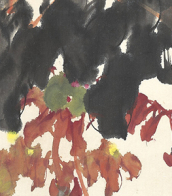

Hsiao Chin is a Chinese modernist painter who has worked in Europe.
Born into an intellectual family in Shanghai, Hsiao moved to Taiwan in 1949 and was educated in the art department of the Taipei Teachers' Training School in Taiwan Province of Taipei (now National Taipei Teachers' University). In 1955, he and seven other artists founded the Ton Fan Art Group, the first postwar contemporary art group in Taiwan that attempted to break free from realism and sought a modern expression of Eastern spirituality.
As an innovative artist and co-founder of significant modernist movements in Taiwan and Europe, Hsiao's work explored Asian philosophy while embracing forms of Western postwar avant-garde practices.
In the mid-1950s, Hsiao settled in Milan, where he lived for half a century. In 1961, along with Italian painter Antonio Calderara and Japanese sculptor Adzuma Kenjiro in Milan, he co-founded the Punto movement, which brought together numerous Eastern and Western abstractionist artists. Xiao Qin's work has been exhibited around the world, including New York's MoMA and Metropolitan Museum of Art, the National Art Museum of China, the Museum of Contemporary Art in Barcelona, and the National Taiwan Museum of Art.


Hsiao Chin is a Chinese modernist painter who has worked in Europe.
Born into an intellectual family in Shanghai, Hsiao moved to Taiwan in 1949 and was educated in the art department of the Taipei Teachers' Training School in Taiwan Province of Taipei (now National Taipei Teachers' University). In 1955, he and seven other artists founded the Ton Fan Art Group, the first postwar contemporary art group in Taiwan that attempted to break free from realism and sought a modern expression of Eastern spirituality.
As an innovative artist and co-founder of significant modernist movements in Taiwan and Europe, Hsiao's work explored Asian philosophy while embracing forms of Western postwar avant-garde practices.
In the mid-1950s, Hsiao settled in Milan, where he lived for half a century. In 1961, along with Italian painter Antonio Calderara and Japanese sculptor Adzuma Kenjiro in Milan, he co-founded the Punto movement, which brought together numerous Eastern and Western abstractionist artists. Xiao Qin's work has been exhibited around the world, including New York's MoMA and Metropolitan Museum of Art, the National Art Museum of China, the Museum of Contemporary Art in Barcelona, and the National Taiwan Museum of Art.
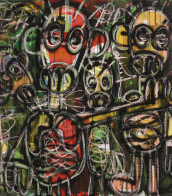

Hsiao Chin is a Chinese modernist painter who has worked in Europe.
Born into an intellectual family in Shanghai, Hsiao moved to Taiwan in 1949 and was educated in the art department of the Taipei Teachers' Training School in Taiwan Province of Taipei (now National Taipei Teachers' University). In 1955, he and seven other artists founded the Ton Fan Art Group, the first postwar contemporary art group in Taiwan that attempted to break free from realism and sought a modern expression of Eastern spirituality.
As an innovative artist and co-founder of significant modernist movements in Taiwan and Europe, Hsiao's work explored Asian philosophy while embracing forms of Western postwar avant-garde practices.
In the mid-1950s, Hsiao settled in Milan, where he lived for half a century. In 1961, along with Italian painter Antonio Calderara and Japanese sculptor Adzuma Kenjiro in Milan, he co-founded the Punto movement, which brought together numerous Eastern and Western abstractionist artists. Xiao Qin's work has been exhibited around the world, including New York's MoMA and Metropolitan Museum of Art, the National Art Museum of China, the Museum of Contemporary Art in Barcelona, and the National Taiwan Museum of Art.
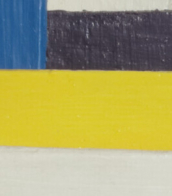

Hsiao Chin is a Chinese modernist painter who has worked in Europe.
Born into an intellectual family in Shanghai, Hsiao moved to Taiwan in 1949 and was educated in the art department of the Taipei Teachers' Training School in Taiwan Province of Taipei (now National Taipei Teachers' University). In 1955, he and seven other artists founded the Ton Fan Art Group, the first postwar contemporary art group in Taiwan that attempted to break free from realism and sought a modern expression of Eastern spirituality.
As an innovative artist and co-founder of significant modernist movements in Taiwan and Europe, Hsiao's work explored Asian philosophy while embracing forms of Western postwar avant-garde practices.
In the mid-1950s, Hsiao settled in Milan, where he lived for half a century. In 1961, along with Italian painter Antonio Calderara and Japanese sculptor Adzuma Kenjiro in Milan, he co-founded the Punto movement, which brought together numerous Eastern and Western abstractionist artists. Xiao Qin's work has been exhibited around the world, including New York's MoMA and Metropolitan Museum of Art, the National Art Museum of China, the Museum of Contemporary Art in Barcelona, and the National Taiwan Museum of Art.
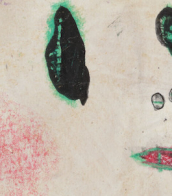

Hsiao Chin is a Chinese modernist painter who has worked in Europe.
Born into an intellectual family in Shanghai, Hsiao moved to Taiwan in 1949 and was educated in the art department of the Taipei Teachers' Training School in Taiwan Province of Taipei (now National Taipei Teachers' University). In 1955, he and seven other artists founded the Ton Fan Art Group, the first postwar contemporary art group in Taiwan that attempted to break free from realism and sought a modern expression of Eastern spirituality.
As an innovative artist and co-founder of significant modernist movements in Taiwan and Europe, Hsiao's work explored Asian philosophy while embracing forms of Western postwar avant-garde practices.
In the mid-1950s, Hsiao settled in Milan, where he lived for half a century. In 1961, along with Italian painter Antonio Calderara and Japanese sculptor Adzuma Kenjiro in Milan, he co-founded the Punto movement, which brought together numerous Eastern and Western abstractionist artists. Xiao Qin's work has been exhibited around the world, including New York's MoMA and Metropolitan Museum of Art, the National Art Museum of China, the Museum of Contemporary Art in Barcelona, and the National Taiwan Museum of Art.
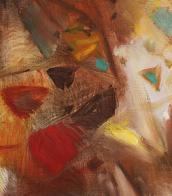

Hsiao Chin is a Chinese modernist painter who has worked in Europe.
Born into an intellectual family in Shanghai, Hsiao moved to Taiwan in 1949 and was educated in the art department of the Taipei Teachers' Training School in Taiwan Province of Taipei (now National Taipei Teachers' University). In 1955, he and seven other artists founded the Ton Fan Art Group, the first postwar contemporary art group in Taiwan that attempted to break free from realism and sought a modern expression of Eastern spirituality.
As an innovative artist and co-founder of significant modernist movements in Taiwan and Europe, Hsiao's work explored Asian philosophy while embracing forms of Western postwar avant-garde practices.
In the mid-1950s, Hsiao settled in Milan, where he lived for half a century. In 1961, along with Italian painter Antonio Calderara and Japanese sculptor Adzuma Kenjiro in Milan, he co-founded the Punto movement, which brought together numerous Eastern and Western abstractionist artists. Xiao Qin's work has been exhibited around the world, including New York's MoMA and Metropolitan Museum of Art, the National Art Museum of China, the Museum of Contemporary Art in Barcelona, and the National Taiwan Museum of Art.
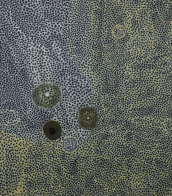

Hsiao Chin is a Chinese modernist painter who has worked in Europe.
Born into an intellectual family in Shanghai, Hsiao moved to Taiwan in 1949 and was educated in the art department of the Taipei Teachers' Training School in Taiwan Province of Taipei (now National Taipei Teachers' University). In 1955, he and seven other artists founded the Ton Fan Art Group, the first postwar contemporary art group in Taiwan that attempted to break free from realism and sought a modern expression of Eastern spirituality.
As an innovative artist and co-founder of significant modernist movements in Taiwan and Europe, Hsiao's work explored Asian philosophy while embracing forms of Western postwar avant-garde practices.
In the mid-1950s, Hsiao settled in Milan, where he lived for half a century. In 1961, along with Italian painter Antonio Calderara and Japanese sculptor Adzuma Kenjiro in Milan, he co-founded the Punto movement, which brought together numerous Eastern and Western abstractionist artists. Xiao Qin's work has been exhibited around the world, including New York's MoMA and Metropolitan Museum of Art, the National Art Museum of China, the Museum of Contemporary Art in Barcelona, and the National Taiwan Museum of Art.
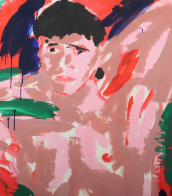

Hsiao Chin is a Chinese modernist painter who has worked in Europe.
Born into an intellectual family in Shanghai, Hsiao moved to Taiwan in 1949 and was educated in the art department of the Taipei Teachers' Training School in Taiwan Province of Taipei (now National Taipei Teachers' University). In 1955, he and seven other artists founded the Ton Fan Art Group, the first postwar contemporary art group in Taiwan that attempted to break free from realism and sought a modern expression of Eastern spirituality.
As an innovative artist and co-founder of significant modernist movements in Taiwan and Europe, Hsiao's work explored Asian philosophy while embracing forms of Western postwar avant-garde practices.
In the mid-1950s, Hsiao settled in Milan, where he lived for half a century. In 1961, along with Italian painter Antonio Calderara and Japanese sculptor Adzuma Kenjiro in Milan, he co-founded the Punto movement, which brought together numerous Eastern and Western abstractionist artists. Xiao Qin's work has been exhibited around the world, including New York's MoMA and Metropolitan Museum of Art, the National Art Museum of China, the Museum of Contemporary Art in Barcelona, and the National Taiwan Museum of Art.


Hsiao Chin is a Chinese modernist painter who has worked in Europe.
Born into an intellectual family in Shanghai, Hsiao moved to Taiwan in 1949 and was educated in the art department of the Taipei Teachers' Training School in Taiwan Province of Taipei (now National Taipei Teachers' University). In 1955, he and seven other artists founded the Ton Fan Art Group, the first postwar contemporary art group in Taiwan that attempted to break free from realism and sought a modern expression of Eastern spirituality.
As an innovative artist and co-founder of significant modernist movements in Taiwan and Europe, Hsiao's work explored Asian philosophy while embracing forms of Western postwar avant-garde practices.
In the mid-1950s, Hsiao settled in Milan, where he lived for half a century. In 1961, along with Italian painter Antonio Calderara and Japanese sculptor Adzuma Kenjiro in Milan, he co-founded the Punto movement, which brought together numerous Eastern and Western abstractionist artists. Xiao Qin's work has been exhibited around the world, including New York's MoMA and Metropolitan Museum of Art, the National Art Museum of China, the Museum of Contemporary Art in Barcelona, and the National Taiwan Museum of Art.
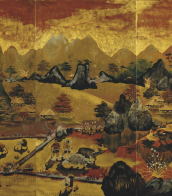

Hsiao Chin is a Chinese modernist painter who has worked in Europe.
Born into an intellectual family in Shanghai, Hsiao moved to Taiwan in 1949 and was educated in the art department of the Taipei Teachers' Training School in Taiwan Province of Taipei (now National Taipei Teachers' University). In 1955, he and seven other artists founded the Ton Fan Art Group, the first postwar contemporary art group in Taiwan that attempted to break free from realism and sought a modern expression of Eastern spirituality.
As an innovative artist and co-founder of significant modernist movements in Taiwan and Europe, Hsiao's work explored Asian philosophy while embracing forms of Western postwar avant-garde practices.
In the mid-1950s, Hsiao settled in Milan, where he lived for half a century. In 1961, along with Italian painter Antonio Calderara and Japanese sculptor Adzuma Kenjiro in Milan, he co-founded the Punto movement, which brought together numerous Eastern and Western abstractionist artists. Xiao Qin's work has been exhibited around the world, including New York's MoMA and Metropolitan Museum of Art, the National Art Museum of China, the Museum of Contemporary Art in Barcelona, and the National Taiwan Museum of Art.


Hsiao Chin is a Chinese modernist painter who has worked in Europe.
Born into an intellectual family in Shanghai, Hsiao moved to Taiwan in 1949 and was educated in the art department of the Taipei Teachers' Training School in Taiwan Province of Taipei (now National Taipei Teachers' University). In 1955, he and seven other artists founded the Ton Fan Art Group, the first postwar contemporary art group in Taiwan that attempted to break free from realism and sought a modern expression of Eastern spirituality.
As an innovative artist and co-founder of significant modernist movements in Taiwan and Europe, Hsiao's work explored Asian philosophy while embracing forms of Western postwar avant-garde practices.
In the mid-1950s, Hsiao settled in Milan, where he lived for half a century. In 1961, along with Italian painter Antonio Calderara and Japanese sculptor Adzuma Kenjiro in Milan, he co-founded the Punto movement, which brought together numerous Eastern and Western abstractionist artists. Xiao Qin's work has been exhibited around the world, including New York's MoMA and Metropolitan Museum of Art, the National Art Museum of China, the Museum of Contemporary Art in Barcelona, and the National Taiwan Museum of Art.
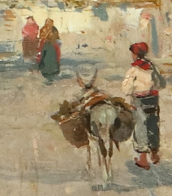

Hsiao Chin is a Chinese modernist painter who has worked in Europe.
Born into an intellectual family in Shanghai, Hsiao moved to Taiwan in 1949 and was educated in the art department of the Taipei Teachers' Training School in Taiwan Province of Taipei (now National Taipei Teachers' University). In 1955, he and seven other artists founded the Ton Fan Art Group, the first postwar contemporary art group in Taiwan that attempted to break free from realism and sought a modern expression of Eastern spirituality.
As an innovative artist and co-founder of significant modernist movements in Taiwan and Europe, Hsiao's work explored Asian philosophy while embracing forms of Western postwar avant-garde practices.
In the mid-1950s, Hsiao settled in Milan, where he lived for half a century. In 1961, along with Italian painter Antonio Calderara and Japanese sculptor Adzuma Kenjiro in Milan, he co-founded the Punto movement, which brought together numerous Eastern and Western abstractionist artists. Xiao Qin's work has been exhibited around the world, including New York's MoMA and Metropolitan Museum of Art, the National Art Museum of China, the Museum of Contemporary Art in Barcelona, and the National Taiwan Museum of Art.
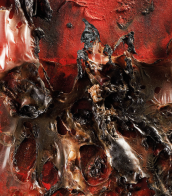

Hsiao Chin is a Chinese modernist painter who has worked in Europe.
Born into an intellectual family in Shanghai, Hsiao moved to Taiwan in 1949 and was educated in the art department of the Taipei Teachers' Training School in Taiwan Province of Taipei (now National Taipei Teachers' University). In 1955, he and seven other artists founded the Ton Fan Art Group, the first postwar contemporary art group in Taiwan that attempted to break free from realism and sought a modern expression of Eastern spirituality.
As an innovative artist and co-founder of significant modernist movements in Taiwan and Europe, Hsiao's work explored Asian philosophy while embracing forms of Western postwar avant-garde practices.
In the mid-1950s, Hsiao settled in Milan, where he lived for half a century. In 1961, along with Italian painter Antonio Calderara and Japanese sculptor Adzuma Kenjiro in Milan, he co-founded the Punto movement, which brought together numerous Eastern and Western abstractionist artists. Xiao Qin's work has been exhibited around the world, including New York's MoMA and Metropolitan Museum of Art, the National Art Museum of China, the Museum of Contemporary Art in Barcelona, and the National Taiwan Museum of Art.
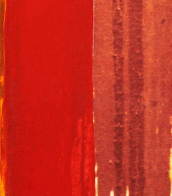

Hsiao Chin is a Chinese modernist painter who has worked in Europe.
Born into an intellectual family in Shanghai, Hsiao moved to Taiwan in 1949 and was educated in the art department of the Taipei Teachers' Training School in Taiwan Province of Taipei (now National Taipei Teachers' University). In 1955, he and seven other artists founded the Ton Fan Art Group, the first postwar contemporary art group in Taiwan that attempted to break free from realism and sought a modern expression of Eastern spirituality.
As an innovative artist and co-founder of significant modernist movements in Taiwan and Europe, Hsiao's work explored Asian philosophy while embracing forms of Western postwar avant-garde practices.
In the mid-1950s, Hsiao settled in Milan, where he lived for half a century. In 1961, along with Italian painter Antonio Calderara and Japanese sculptor Adzuma Kenjiro in Milan, he co-founded the Punto movement, which brought together numerous Eastern and Western abstractionist artists. Xiao Qin's work has been exhibited around the world, including New York's MoMA and Metropolitan Museum of Art, the National Art Museum of China, the Museum of Contemporary Art in Barcelona, and the National Taiwan Museum of Art.


Hsiao Chin is a Chinese modernist painter who has worked in Europe.
Born into an intellectual family in Shanghai, Hsiao moved to Taiwan in 1949 and was educated in the art department of the Taipei Teachers' Training School in Taiwan Province of Taipei (now National Taipei Teachers' University). In 1955, he and seven other artists founded the Ton Fan Art Group, the first postwar contemporary art group in Taiwan that attempted to break free from realism and sought a modern expression of Eastern spirituality.
As an innovative artist and co-founder of significant modernist movements in Taiwan and Europe, Hsiao's work explored Asian philosophy while embracing forms of Western postwar avant-garde practices.
In the mid-1950s, Hsiao settled in Milan, where he lived for half a century. In 1961, along with Italian painter Antonio Calderara and Japanese sculptor Adzuma Kenjiro in Milan, he co-founded the Punto movement, which brought together numerous Eastern and Western abstractionist artists. Xiao Qin's work has been exhibited around the world, including New York's MoMA and Metropolitan Museum of Art, the National Art Museum of China, the Museum of Contemporary Art in Barcelona, and the National Taiwan Museum of Art.


Hsiao Chin is a Chinese modernist painter who has worked in Europe.
Born into an intellectual family in Shanghai, Hsiao moved to Taiwan in 1949 and was educated in the art department of the Taipei Teachers' Training School in Taiwan Province of Taipei (now National Taipei Teachers' University). In 1955, he and seven other artists founded the Ton Fan Art Group, the first postwar contemporary art group in Taiwan that attempted to break free from realism and sought a modern expression of Eastern spirituality.
As an innovative artist and co-founder of significant modernist movements in Taiwan and Europe, Hsiao's work explored Asian philosophy while embracing forms of Western postwar avant-garde practices.
In the mid-1950s, Hsiao settled in Milan, where he lived for half a century. In 1961, along with Italian painter Antonio Calderara and Japanese sculptor Adzuma Kenjiro in Milan, he co-founded the Punto movement, which brought together numerous Eastern and Western abstractionist artists. Xiao Qin's work has been exhibited around the world, including New York's MoMA and Metropolitan Museum of Art, the National Art Museum of China, the Museum of Contemporary Art in Barcelona, and the National Taiwan Museum of Art.
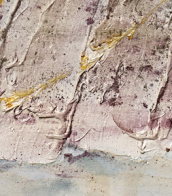

Hsiao Chin is a Chinese modernist painter who has worked in Europe.
Born into an intellectual family in Shanghai, Hsiao moved to Taiwan in 1949 and was educated in the art department of the Taipei Teachers' Training School in Taiwan Province of Taipei (now National Taipei Teachers' University). In 1955, he and seven other artists founded the Ton Fan Art Group, the first postwar contemporary art group in Taiwan that attempted to break free from realism and sought a modern expression of Eastern spirituality.
As an innovative artist and co-founder of significant modernist movements in Taiwan and Europe, Hsiao's work explored Asian philosophy while embracing forms of Western postwar avant-garde practices.
In the mid-1950s, Hsiao settled in Milan, where he lived for half a century. In 1961, along with Italian painter Antonio Calderara and Japanese sculptor Adzuma Kenjiro in Milan, he co-founded the Punto movement, which brought together numerous Eastern and Western abstractionist artists. Xiao Qin's work has been exhibited around the world, including New York's MoMA and Metropolitan Museum of Art, the National Art Museum of China, the Museum of Contemporary Art in Barcelona, and the National Taiwan Museum of Art.


Hsiao Chin is a Chinese modernist painter who has worked in Europe.
Born into an intellectual family in Shanghai, Hsiao moved to Taiwan in 1949 and was educated in the art department of the Taipei Teachers' Training School in Taiwan Province of Taipei (now National Taipei Teachers' University). In 1955, he and seven other artists founded the Ton Fan Art Group, the first postwar contemporary art group in Taiwan that attempted to break free from realism and sought a modern expression of Eastern spirituality.
As an innovative artist and co-founder of significant modernist movements in Taiwan and Europe, Hsiao's work explored Asian philosophy while embracing forms of Western postwar avant-garde practices.
In the mid-1950s, Hsiao settled in Milan, where he lived for half a century. In 1961, along with Italian painter Antonio Calderara and Japanese sculptor Adzuma Kenjiro in Milan, he co-founded the Punto movement, which brought together numerous Eastern and Western abstractionist artists. Xiao Qin's work has been exhibited around the world, including New York's MoMA and Metropolitan Museum of Art, the National Art Museum of China, the Museum of Contemporary Art in Barcelona, and the National Taiwan Museum of Art.
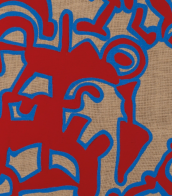

Hsiao Chin is a Chinese modernist painter who has worked in Europe.
Born into an intellectual family in Shanghai, Hsiao moved to Taiwan in 1949 and was educated in the art department of the Taipei Teachers' Training School in Taiwan Province of Taipei (now National Taipei Teachers' University). In 1955, he and seven other artists founded the Ton Fan Art Group, the first postwar contemporary art group in Taiwan that attempted to break free from realism and sought a modern expression of Eastern spirituality.
As an innovative artist and co-founder of significant modernist movements in Taiwan and Europe, Hsiao's work explored Asian philosophy while embracing forms of Western postwar avant-garde practices.
In the mid-1950s, Hsiao settled in Milan, where he lived for half a century. In 1961, along with Italian painter Antonio Calderara and Japanese sculptor Adzuma Kenjiro in Milan, he co-founded the Punto movement, which brought together numerous Eastern and Western abstractionist artists. Xiao Qin's work has been exhibited around the world, including New York's MoMA and Metropolitan Museum of Art, the National Art Museum of China, the Museum of Contemporary Art in Barcelona, and the National Taiwan Museum of Art.
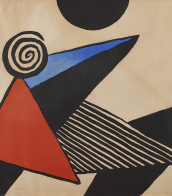

Hsiao Chin is a Chinese modernist painter who has worked in Europe.
Born into an intellectual family in Shanghai, Hsiao moved to Taiwan in 1949 and was educated in the art department of the Taipei Teachers' Training School in Taiwan Province of Taipei (now National Taipei Teachers' University). In 1955, he and seven other artists founded the Ton Fan Art Group, the first postwar contemporary art group in Taiwan that attempted to break free from realism and sought a modern expression of Eastern spirituality.
As an innovative artist and co-founder of significant modernist movements in Taiwan and Europe, Hsiao's work explored Asian philosophy while embracing forms of Western postwar avant-garde practices.
In the mid-1950s, Hsiao settled in Milan, where he lived for half a century. In 1961, along with Italian painter Antonio Calderara and Japanese sculptor Adzuma Kenjiro in Milan, he co-founded the Punto movement, which brought together numerous Eastern and Western abstractionist artists. Xiao Qin's work has been exhibited around the world, including New York's MoMA and Metropolitan Museum of Art, the National Art Museum of China, the Museum of Contemporary Art in Barcelona, and the National Taiwan Museum of Art.


Hsiao Chin is a Chinese modernist painter who has worked in Europe.
Born into an intellectual family in Shanghai, Hsiao moved to Taiwan in 1949 and was educated in the art department of the Taipei Teachers' Training School in Taiwan Province of Taipei (now National Taipei Teachers' University). In 1955, he and seven other artists founded the Ton Fan Art Group, the first postwar contemporary art group in Taiwan that attempted to break free from realism and sought a modern expression of Eastern spirituality.
As an innovative artist and co-founder of significant modernist movements in Taiwan and Europe, Hsiao's work explored Asian philosophy while embracing forms of Western postwar avant-garde practices.
In the mid-1950s, Hsiao settled in Milan, where he lived for half a century. In 1961, along with Italian painter Antonio Calderara and Japanese sculptor Adzuma Kenjiro in Milan, he co-founded the Punto movement, which brought together numerous Eastern and Western abstractionist artists. Xiao Qin's work has been exhibited around the world, including New York's MoMA and Metropolitan Museum of Art, the National Art Museum of China, the Museum of Contemporary Art in Barcelona, and the National Taiwan Museum of Art.


Hsiao Chin is a Chinese modernist painter who has worked in Europe.
Born into an intellectual family in Shanghai, Hsiao moved to Taiwan in 1949 and was educated in the art department of the Taipei Teachers' Training School in Taiwan Province of Taipei (now National Taipei Teachers' University). In 1955, he and seven other artists founded the Ton Fan Art Group, the first postwar contemporary art group in Taiwan that attempted to break free from realism and sought a modern expression of Eastern spirituality.
As an innovative artist and co-founder of significant modernist movements in Taiwan and Europe, Hsiao's work explored Asian philosophy while embracing forms of Western postwar avant-garde practices.
In the mid-1950s, Hsiao settled in Milan, where he lived for half a century. In 1961, along with Italian painter Antonio Calderara and Japanese sculptor Adzuma Kenjiro in Milan, he co-founded the Punto movement, which brought together numerous Eastern and Western abstractionist artists. Xiao Qin's work has been exhibited around the world, including New York's MoMA and Metropolitan Museum of Art, the National Art Museum of China, the Museum of Contemporary Art in Barcelona, and the National Taiwan Museum of Art.


Hsiao Chin is a Chinese modernist painter who has worked in Europe.
Born into an intellectual family in Shanghai, Hsiao moved to Taiwan in 1949 and was educated in the art department of the Taipei Teachers' Training School in Taiwan Province of Taipei (now National Taipei Teachers' University). In 1955, he and seven other artists founded the Ton Fan Art Group, the first postwar contemporary art group in Taiwan that attempted to break free from realism and sought a modern expression of Eastern spirituality.
As an innovative artist and co-founder of significant modernist movements in Taiwan and Europe, Hsiao's work explored Asian philosophy while embracing forms of Western postwar avant-garde practices.
In the mid-1950s, Hsiao settled in Milan, where he lived for half a century. In 1961, along with Italian painter Antonio Calderara and Japanese sculptor Adzuma Kenjiro in Milan, he co-founded the Punto movement, which brought together numerous Eastern and Western abstractionist artists. Xiao Qin's work has been exhibited around the world, including New York's MoMA and Metropolitan Museum of Art, the National Art Museum of China, the Museum of Contemporary Art in Barcelona, and the National Taiwan Museum of Art.
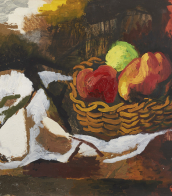

Hsiao Chin is a Chinese modernist painter who has worked in Europe.
Born into an intellectual family in Shanghai, Hsiao moved to Taiwan in 1949 and was educated in the art department of the Taipei Teachers' Training School in Taiwan Province of Taipei (now National Taipei Teachers' University). In 1955, he and seven other artists founded the Ton Fan Art Group, the first postwar contemporary art group in Taiwan that attempted to break free from realism and sought a modern expression of Eastern spirituality.
As an innovative artist and co-founder of significant modernist movements in Taiwan and Europe, Hsiao's work explored Asian philosophy while embracing forms of Western postwar avant-garde practices.
In the mid-1950s, Hsiao settled in Milan, where he lived for half a century. In 1961, along with Italian painter Antonio Calderara and Japanese sculptor Adzuma Kenjiro in Milan, he co-founded the Punto movement, which brought together numerous Eastern and Western abstractionist artists. Xiao Qin's work has been exhibited around the world, including New York's MoMA and Metropolitan Museum of Art, the National Art Museum of China, the Museum of Contemporary Art in Barcelona, and the National Taiwan Museum of Art.
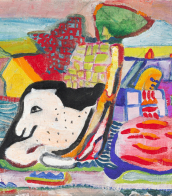

Hsiao Chin is a Chinese modernist painter who has worked in Europe.
Born into an intellectual family in Shanghai, Hsiao moved to Taiwan in 1949 and was educated in the art department of the Taipei Teachers' Training School in Taiwan Province of Taipei (now National Taipei Teachers' University). In 1955, he and seven other artists founded the Ton Fan Art Group, the first postwar contemporary art group in Taiwan that attempted to break free from realism and sought a modern expression of Eastern spirituality.
As an innovative artist and co-founder of significant modernist movements in Taiwan and Europe, Hsiao's work explored Asian philosophy while embracing forms of Western postwar avant-garde practices.
In the mid-1950s, Hsiao settled in Milan, where he lived for half a century. In 1961, along with Italian painter Antonio Calderara and Japanese sculptor Adzuma Kenjiro in Milan, he co-founded the Punto movement, which brought together numerous Eastern and Western abstractionist artists. Xiao Qin's work has been exhibited around the world, including New York's MoMA and Metropolitan Museum of Art, the National Art Museum of China, the Museum of Contemporary Art in Barcelona, and the National Taiwan Museum of Art.


Hsiao Chin is a Chinese modernist painter who has worked in Europe.
Born into an intellectual family in Shanghai, Hsiao moved to Taiwan in 1949 and was educated in the art department of the Taipei Teachers' Training School in Taiwan Province of Taipei (now National Taipei Teachers' University). In 1955, he and seven other artists founded the Ton Fan Art Group, the first postwar contemporary art group in Taiwan that attempted to break free from realism and sought a modern expression of Eastern spirituality.
As an innovative artist and co-founder of significant modernist movements in Taiwan and Europe, Hsiao's work explored Asian philosophy while embracing forms of Western postwar avant-garde practices.
In the mid-1950s, Hsiao settled in Milan, where he lived for half a century. In 1961, along with Italian painter Antonio Calderara and Japanese sculptor Adzuma Kenjiro in Milan, he co-founded the Punto movement, which brought together numerous Eastern and Western abstractionist artists. Xiao Qin's work has been exhibited around the world, including New York's MoMA and Metropolitan Museum of Art, the National Art Museum of China, the Museum of Contemporary Art in Barcelona, and the National Taiwan Museum of Art.


Hsiao Chin is a Chinese modernist painter who has worked in Europe.
Born into an intellectual family in Shanghai, Hsiao moved to Taiwan in 1949 and was educated in the art department of the Taipei Teachers' Training School in Taiwan Province of Taipei (now National Taipei Teachers' University). In 1955, he and seven other artists founded the Ton Fan Art Group, the first postwar contemporary art group in Taiwan that attempted to break free from realism and sought a modern expression of Eastern spirituality.
As an innovative artist and co-founder of significant modernist movements in Taiwan and Europe, Hsiao's work explored Asian philosophy while embracing forms of Western postwar avant-garde practices.
In the mid-1950s, Hsiao settled in Milan, where he lived for half a century. In 1961, along with Italian painter Antonio Calderara and Japanese sculptor Adzuma Kenjiro in Milan, he co-founded the Punto movement, which brought together numerous Eastern and Western abstractionist artists. Xiao Qin's work has been exhibited around the world, including New York's MoMA and Metropolitan Museum of Art, the National Art Museum of China, the Museum of Contemporary Art in Barcelona, and the National Taiwan Museum of Art.


Hsiao Chin is a Chinese modernist painter who has worked in Europe.
Born into an intellectual family in Shanghai, Hsiao moved to Taiwan in 1949 and was educated in the art department of the Taipei Teachers' Training School in Taiwan Province of Taipei (now National Taipei Teachers' University). In 1955, he and seven other artists founded the Ton Fan Art Group, the first postwar contemporary art group in Taiwan that attempted to break free from realism and sought a modern expression of Eastern spirituality.
As an innovative artist and co-founder of significant modernist movements in Taiwan and Europe, Hsiao's work explored Asian philosophy while embracing forms of Western postwar avant-garde practices.
In the mid-1950s, Hsiao settled in Milan, where he lived for half a century. In 1961, along with Italian painter Antonio Calderara and Japanese sculptor Adzuma Kenjiro in Milan, he co-founded the Punto movement, which brought together numerous Eastern and Western abstractionist artists. Xiao Qin's work has been exhibited around the world, including New York's MoMA and Metropolitan Museum of Art, the National Art Museum of China, the Museum of Contemporary Art in Barcelona, and the National Taiwan Museum of Art.
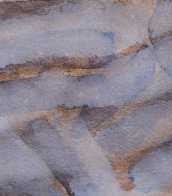

Hsiao Chin is a Chinese modernist painter who has worked in Europe.
Born into an intellectual family in Shanghai, Hsiao moved to Taiwan in 1949 and was educated in the art department of the Taipei Teachers' Training School in Taiwan Province of Taipei (now National Taipei Teachers' University). In 1955, he and seven other artists founded the Ton Fan Art Group, the first postwar contemporary art group in Taiwan that attempted to break free from realism and sought a modern expression of Eastern spirituality.
As an innovative artist and co-founder of significant modernist movements in Taiwan and Europe, Hsiao's work explored Asian philosophy while embracing forms of Western postwar avant-garde practices.
In the mid-1950s, Hsiao settled in Milan, where he lived for half a century. In 1961, along with Italian painter Antonio Calderara and Japanese sculptor Adzuma Kenjiro in Milan, he co-founded the Punto movement, which brought together numerous Eastern and Western abstractionist artists. Xiao Qin's work has been exhibited around the world, including New York's MoMA and Metropolitan Museum of Art, the National Art Museum of China, the Museum of Contemporary Art in Barcelona, and the National Taiwan Museum of Art.
